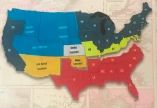In January 1860, another presidential election year was beginning. While hoping for better things to come, the mood of the nation was that the stability of the country was in jeopardy. The recent Supreme Court Dred Scott decision ruled that outlawing slavery above the old 1820’s Missouri Compromise line was illegal. The adoption of the Kansas-Nebraska Act allowing territorial residents to decide whether to allow slavery had erupted in violence in the Kansas territory. The Fugitive Slave Act was being ignored by many northern communities. And within the past few months, John Brown had been put to death because he attempted to incite an insurrection of the local slaves. By doing so, he put into action what every slave owner dreaded; an insurrection of their slaves. California and Oregon had recently become slavery-free states and there was no agreement whether the slave-holding states would be allowed to bring their slaves into the remaining large territories in the west. So, the upcoming presidential election took on a new urgency for the South; the continuation of a slavery condoning President.
The next sixteen months will prove to be momentous for the country. In two riotous conventions, filled with threats and fights, the Democrat Party will split in two, nominating two presidential candidates. By December a new President will have been elected that does not support slavery expansion into the territories and before the year was out, one state will have created a Constitutional crisis by seceding from the Union. The country slowly tears apart as it simultaneously looks for solutions and prepares for war until the rift culminates at Ft. Sumner. And as the house divides, all of this will have been covered by the local newspapers, espousing their own particular views about these events.
